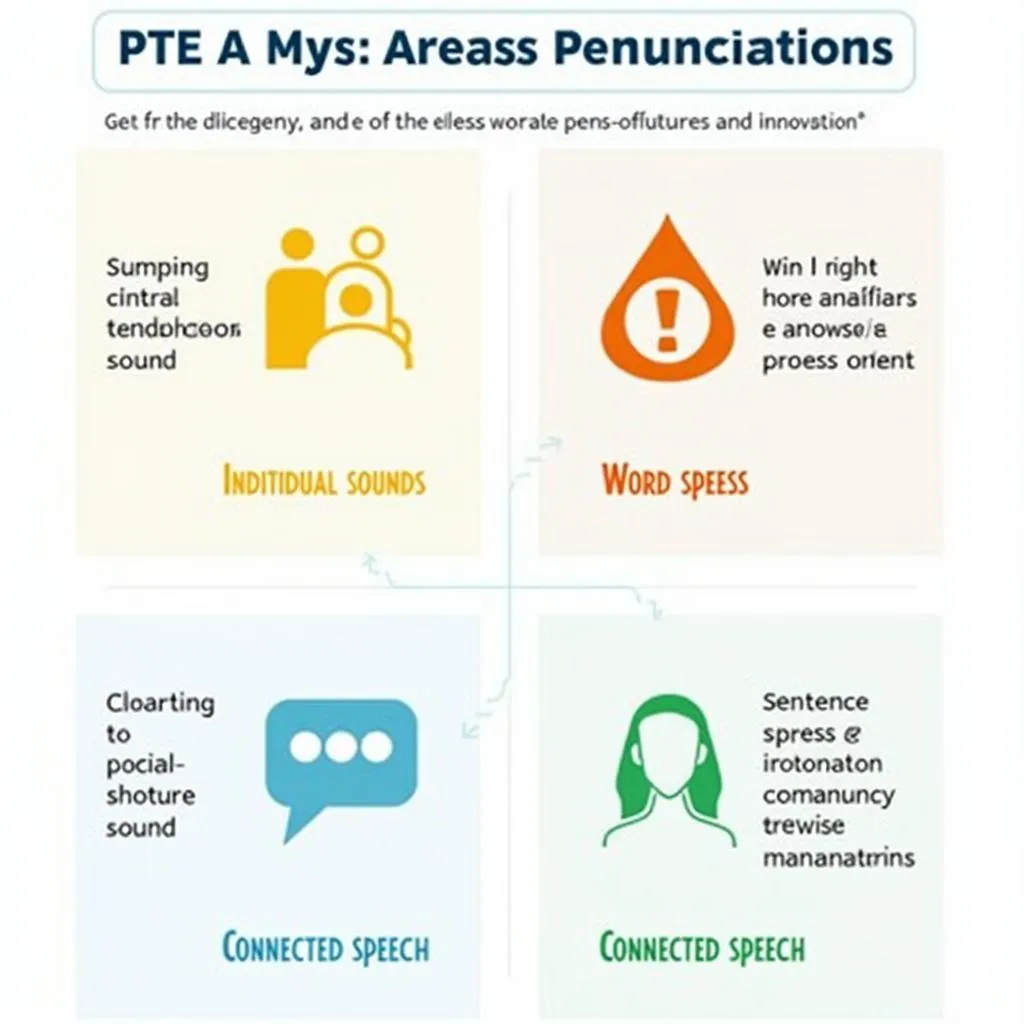Are you struggling with PTE pronunciation? You’re not alone. Many test-takers find this aspect of the exam challenging, but with the right approach, you can significantly improve your skills. In this comprehensive guide, we’ll explore effective PTE Pronunciation Exercises that will boost your confidence and help you achieve your desired score.
Understanding the Importance of Pronunciation in PTE
Pronunciation plays a crucial role in the PTE Academic exam, particularly in the Speaking section. It accounts for 5 points out of the 90-point scale, which may seem small but can make a significant difference in your overall score. Moreover, clear pronunciation enhances your performance in other speaking tasks, such as Read Aloud and Repeat Sentence.
How to prepare for PTE in 3 months is an essential guide that can help you structure your practice, including pronunciation exercises, for optimal results.
Key Areas to Focus on for PTE Pronunciation
Before diving into specific exercises, it’s important to understand the key areas that the PTE exam focuses on:
- Individual sounds (phonemes)
- Word stress
- Sentence stress and intonation
- Connected speech
By targeting these areas in your practice, you’ll be well-prepared for the pronunciation challenges in the PTE Academic exam.
 Key Areas of PTE Pronunciation
Key Areas of PTE Pronunciation
Effective PTE Pronunciation Exercises
1. Minimal Pairs Practice
Minimal pairs are words that differ by only one sound. Practicing these can help you distinguish and produce similar sounds accurately.
Exercise:
- Create a list of minimal pairs relevant to your language background (e.g., “ship” vs. “sheep” for many Asian language speakers)
- Record yourself saying each word
- Listen back and compare with native speaker pronunciations
- Focus on the subtle differences and practice until you can consistently produce the correct sound
2. Tongue Twisters
Tongue twisters are an excellent way to improve your articulation and fluency.
Exercise:
- Start with simple tongue twisters and gradually move to more complex ones
- Practice saying them slowly at first, then increase your speed
- Focus on maintaining clarity even as you speed up
Example tongue twister:
“Peter Piper picked a peck of pickled peppers.”
3. Stress and Intonation Drills
Word stress and sentence intonation are crucial for natural-sounding English.
Exercise:
- Choose a paragraph from a PTE practice text
- Mark the stressed syllables in multi-syllable words
- Practice reading the paragraph aloud, emphasizing the correct syllables
- Pay attention to the rise and fall of your voice in questions and statements
How to practice speaking under pressure for PTE offers valuable tips that can be applied to these pronunciation exercises, helping you maintain clarity even in stressful situations.
4. Shadowing Technique
Shadowing involves listening to a native speaker and repeating what they say in real-time, mimicking their pronunciation and intonation.
Exercise:
- Choose a short audio clip from a PTE practice resource
- Listen to the clip once to understand the content
- Play it again, this time repeating what you hear immediately after the speaker
- Focus on matching the speaker’s rhythm, stress, and intonation
 Shadowing Technique for PTE Pronunciation
Shadowing Technique for PTE Pronunciation
5. Record and Compare
This exercise helps you identify and correct your pronunciation errors.
Exercise:
- Choose a short passage from PTE reading materials
- Record yourself reading it aloud
- Listen to a native speaker’s version of the same passage
- Compare your pronunciation with the native speaker’s
- Note any differences and practice the challenging words or phrases
Dr. Emma Thompson, a renowned PTE coach, emphasizes the importance of this exercise:
“Self-recording and comparison is one of the most effective ways to improve pronunciation. It allows students to hear their mistakes and track their progress over time.”
6. Vowel and Consonant Focus
English has sounds that may not exist in your native language. Focusing on these can significantly improve your pronunciation.
Exercise:
- Identify the sounds that are most challenging for speakers of your native language
- Practice producing these sounds in isolation
- Gradually incorporate them into words and sentences
- Use online resources or a pronunciation app for guidance on mouth and tongue positions
PTE listening module accent diversity can provide insights into various English accents, which is beneficial for both pronunciation and listening skills.
7. Connected Speech Practice
In natural English speech, words often blend together. Understanding and practicing connected speech can improve both your pronunciation and listening comprehension.
Exercise:
- Study common connected speech patterns (e.g., linking, elision, assimilation)
- Practice with sentences that demonstrate these patterns
- Record yourself and compare with native speaker examples
Example:
“What do you want to eat?” often sounds like “Whaddya wanna eat?”
Incorporating Technology in Your PTE Pronunciation Exercises
Modern technology offers numerous tools to enhance your pronunciation practice:
- Pronunciation apps (e.g., ELSA Speak, Speechling)
- Text-to-speech software for listening to correct pronunciations
- Speech recognition software to check your pronunciation accuracy
- Online dictionaries with audio pronunciations
How to practice pronunciation with native speakers for PTE provides additional strategies for leveraging technology and human interaction to improve your pronunciation skills.
 Technology Tools for PTE Pronunciation Practice
Technology Tools for PTE Pronunciation Practice
Creating a Consistent Practice Routine
Consistency is key when it comes to improving your pronunciation. Here’s a suggested weekly routine:
- Monday: Minimal pairs and individual sound practice
- Tuesday: Tongue twisters and articulation exercises
- Wednesday: Stress and intonation drills
- Thursday: Shadowing practice
- Friday: Record and compare exercise
- Saturday: Vowel and consonant focus
- Sunday: Connected speech practice and review of the week’s progress
Dedicate at least 30 minutes each day to these exercises, and you’ll see significant improvement over time.
Conclusion
Improving your pronunciation for the PTE Academic exam requires dedication and consistent practice. By incorporating these PTE pronunciation exercises into your study routine, you’ll not only enhance your speaking skills but also boost your overall confidence in English communication. Remember, progress may be gradual, but with persistence, you’ll achieve the clear, natural pronunciation that PTE examiners are looking for.
PTE academic exam tips for non-native speakers offers additional strategies that complement these pronunciation exercises, providing a well-rounded approach to PTE preparation.
Start practicing today, and watch your PTE pronunciation skills soar!
Frequently Asked Questions
How long should I practice pronunciation each day for PTE?
Aim for at least 30 minutes of focused pronunciation practice daily. Consistency is more important than long, infrequent sessions.
Can I improve my PTE pronunciation without a tutor?
Yes, you can significantly improve your pronunciation through self-study using the exercises outlined in this article, along with online resources and pronunciation apps.
What’s the fastest way to improve pronunciation for PTE?
While there’s no “quick fix,” combining regular practice of minimal pairs, shadowing, and recording yourself can lead to rapid improvement.
How important is accent reduction for PTE pronunciation?
PTE doesn’t require a specific accent. Focus on clarity and intelligibility rather than trying to mimic a particular accent.
Are there any pronunciation features specific to PTE that I should focus on?
PTE emphasizes clear articulation, proper stress, and natural intonation. Pay special attention to commonly confused sounds in English.
How can I tell if my pronunciation is improving for PTE?
Record yourself regularly and compare your recordings over time. You can also use speech recognition software to check your accuracy.
Is it necessary to learn phonetic symbols for PTE pronunciation practice?
While not strictly necessary, understanding phonetic symbols can be helpful for precise pronunciation practice, especially when using dictionaries.